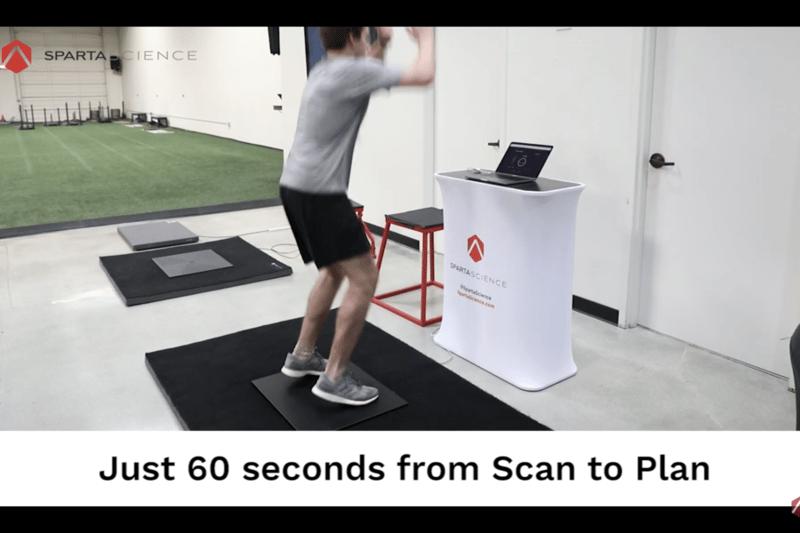
Tech company Sparta Science is pairing force-plate technology with machine learning to help Air Force Special Operations Command’s 24th Special Operations Wing predict and prevent injuries in its special tactics Airmen.
“The 24th SOW Human Performance team is consistently looking for innovative ways to assess, maintain, and enhance the health and performance of our most valued asset, our special tactics Airmen,” Hunter Treuchet, the Human Performance program director with the wing, said in a release. “Acquiring force plates and machine learning technology allows for an objective assessment and identification of potential musculoskeletal issues, which could impact operator readiness.”
Sparta Science Founder and CEO Dr. Phil Wagner told Air Force Magazine a force plate can be likened to “a high-power bathroom scale.”
“It measures how you stand or jump in three different directions in about 3,000 points a second,” he explained. The process involves scanning an individual while they’re in a plank position, while they balance on one foot, and during a jump, according to a video demonstrating the process.
Video: Sparta Science on YouTube
According to Sparta’s website, these force plate scans gauge “unique movement qualities” and machine learning lets the company chart how an individual measures up against an in-house “database of over 2 million scans, generating your Movement Signature instantly.”
From there, Sparta and its partners—who also include other segments of the Air Force, Army, Navy, and U.S. Special Operations Command—can focus on injury prevention, since Sparta’s software generates personalized training plans based on individuals’ force-plate scans.
This technology means troops can track their progress as they work to counter these musculoskeletal vulnerabilities, since subsequent scans can be compared with one another. It can also theoretically be used to create a service member profile, from Military Entrance Processing to their eventual squadron assignment, so they can train to stop injuries and enhance their performance, said retired Army Maj. Gen. Malcolm B. Frost, the former head of the U.S. Army Center for Initial Military Training who now serves as a strategic advisor with Sparta.
“I think the ultimate goal we’re trying to do is create this vital sign, so … wherever you are, like, you can quickly be measured by this compared against your history or others’ so you get the best plan to be healthy, right?” Wagner said.
Wagner said this innovation, collectively referred to as “Force Plate Machine Learning,” or FPML, for short, enables Sparta to create profiles for what a scan from a member of a certain service or a service member within a particular AFSC might look like.
“How do we fit both the occupational role and the injury risk from all this data coming in?” he said.
Wagner said that while ACL vulnerabilities are among the most common when scanning athletes, “the big three” kinds of injuries Sparta sees within the Air Force special tactics community impact the lower back, knees, and ankles. The lower-back troubles can be traced back to rucking and the use of body armor, he said.
Frost said these observations make sense when one remembers that special tactics Airmen work “side by side with” elite forces like the Navy SEALs, Special Forces personnel, and U.S. Army Rangers.
“It is in line with a lot of what I would kind of call that classic, high-end infantry-type mission, … although they do some other special things, and that rides right into, you know, the injuries, the types … [we are] seeing through the machine learning,” he said.
Sparta’s also collaborating with the Air Force Research Laboratory to see if FPML can be used to help predict and prevent neck pain in USAF pilots, Wagner said.
“Jets are faster, helmets are heavier, right, and so as a result, there’s quite a significant amount of stress on the head and the neck region,” he said. “And so we have a plank test, and so doing that plank position on the plate allows us to identify neck pain and potential neck injuries.”
Sparta aspires to spread the use of FPML not only more widely within the Defense Department, but also to allies overseas, Wagner said.
Though Wagner couldn’t provide numbers as to how accurate these force-plate scans for the military are, he said that when the same technology is used for athletes, its “sensitivity specificity is about 76 percent.” For context, he said, mammograms are typically around 72 percent, and blood pressure cuffs are around 80 percent.
“So, you know, at least compared to other standards, within data we’ve published and research, it’s right up there with a lot of common diagnostic tools, whether it’s [a] blood pressure cuff or a mammogram,” he said.
The longer military units utilize Force Plate Machine Learning, the more data they’ll accrue and the more predictable the resulting reports will become, Frost noted. However, he said, U.S. military organizations and units have reported back that the technology is “absolutely a factor that’s helping,” he said.
The company is also working to ensure that its fast database of scans doesn’t pose an unintended threat to operational security, Wagner added.
“We’re actively pursuing an ATO authority to operate with different branches to operate within the government intranet, and … pursuing FedRAMP certification, which is [a] services-wide approach of being on the government intranet,” he said. “In the interim, most organizations within the military are using an offline, air-gapped solution, so it’s only on that device, so there’s no way to actually penetrate that through the internet, or, you know, other outside means.”